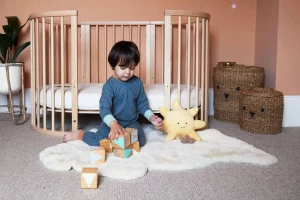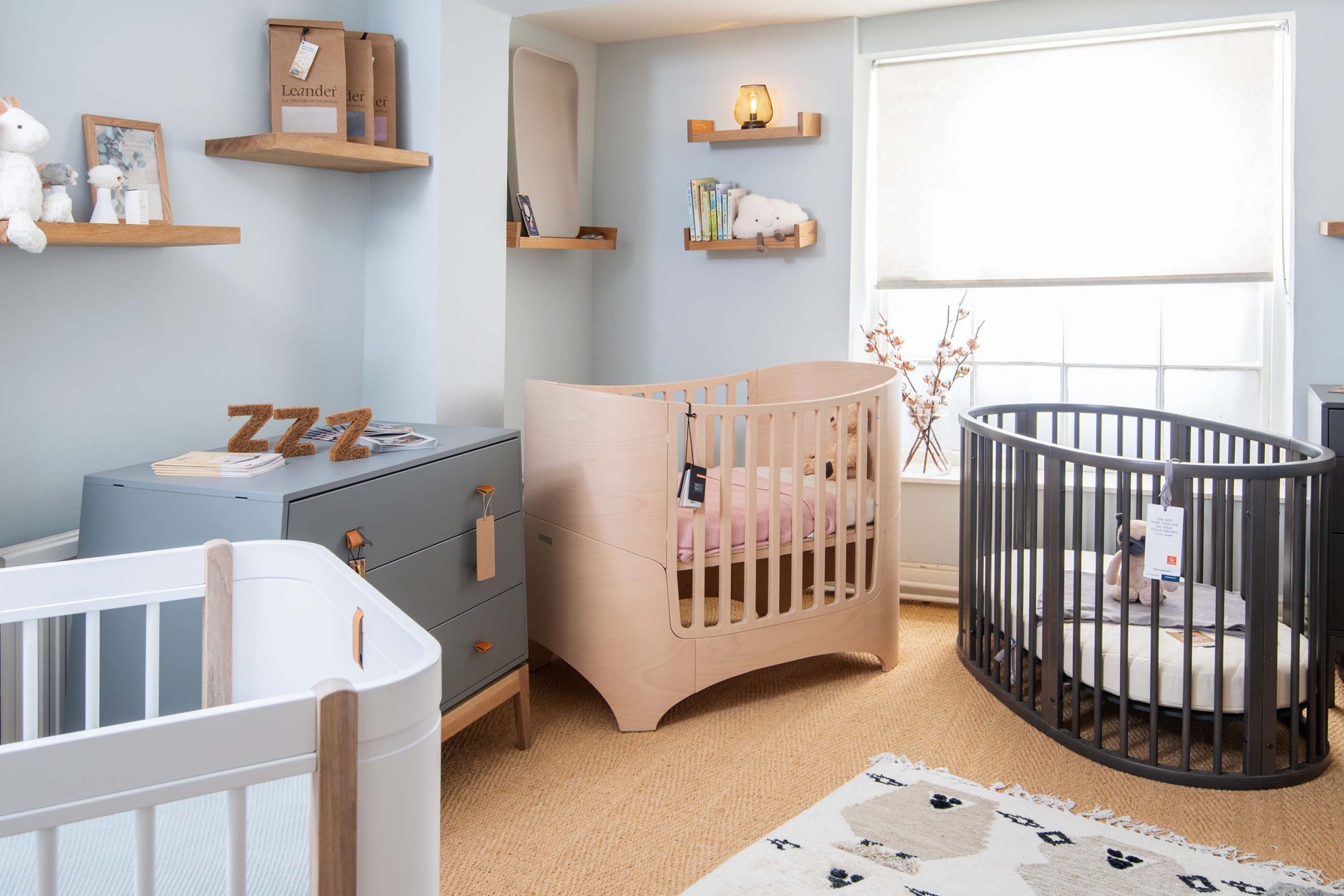Welcoming a new member to your family is an exciting journey filled with joy, and setting up a cozy and functional nursery is a significant part of the preparation. When it comes to choosing a sleeping solution for your baby, cots and cot beds stand out for their dual-purpose functionality. These versatile pieces of furniture provide a secure and comfortable sleeping space for infants while seamlessly evolving to meet the changing needs of your growing child. In this comprehensive guide, we will explore the journey of cots and cot beds, from the early days of infancy to the toddler years, highlighting their adaptability and the benefits they bring to your child’s sleep environment.
Understanding Cots and Cot Beds:
1. Cots:
Cots are typically designed for newborns and younger infants. They feature high sides to create a secure and enclosed sleeping space for the baby. Cots are known for their simplicity and focus on providing a safe and comfortable environment for the earliest stages of a child’s life.
2. Cot Beds:
Cot beds, on the other hand, offer a dual-purpose design that evolves with your child. Initially, they function as traditional cots with high sides, providing a snug sleeping space for infants. As your child grows, cot beds can be transformed into toddler beds by removing one or both sides, creating a low-profile bed suitable for toddlers transitioning from a cot.
3. The Evolutionary Journey:
The evolutionary journey of cots and cot beds reflects their ability to adapt to the changing needs of your child. From a secure and enclosed space for the newborn to a more open and accessible sleeping area for the toddler, these pieces of furniture are designed to grow with your child.
4. Key Features:
Both cots and cot beds come with key features such as adjustable mattress heights, teething rails, and the option to convert into toddler beds. These features contribute to the longevity and versatility of these sleep solutions.
Creating a Secure Haven for Infants:
1. Enclosed Sleeping Space:
Cots provide an enclosed sleeping space with high sides, creating a secure and comforting environment for newborns. The elevated sides help prevent the baby from rolling out and provide a sense of containment.
2. Adjustable Mattress Heights:
Many cots and cot beds come with adjustable mattress heights. In the early days, you can position the mattress at a higher level, making it easier to lift and place the baby in the cot without straining your back.
3. Teething Rails:
Teething rails are a common feature in cots and cot beds. These protective covers along the top edges safeguard the cot from teething babies who may chew on the rails. This feature helps maintain the integrity of the furniture.
4. Simple and Functional Design:
Cots and cot beds are designed with simplicity and functionality in mind. They focus on providing a safe and comfortable sleeping space without unnecessary frills. This straightforward design is ideal for the early days of infancy.
Adapting to the Toddler Years:
1. Convertible Design:
One of the standout features of cot beds is their convertible design. As your child grows and reaches the toddler stage, the cot bed can be transformed into a toddler bed by removing one or both of the high sides. This conversion extends the usability of the furniture.
2. Low-Profile Sleeping Area:
Once converted, cot beds become low-profile beds that are closer to the ground. This design is well-suited for toddlers who are transitioning from the security of the cot to a more independent sleeping space.
3. Accessibility for Toddlers:
Cot beds with one or both sides removed offer easy accessibility for toddlers. This allows them to get in and out of bed independently, fostering a sense of autonomy as they progress through their toddler years.
4. Continued Use of Adjustable Mattress Heights:
Even as a cot bed transitions into a toddler bed, the adjustable mattress heights remain a valuable feature. Lowering the mattress as your child grows ensures a safe and comfortable sleeping position.
5. Extended Longevity:
The ability of cot beds to evolve into toddler beds contributes to their extended longevity. This dual-purpose functionality means that the furniture remains a staple in your child’s room for a more extended period compared to a standard cot.
Choosing the Right Bed for Your Child:
1. Consider Long-Term Use:
When selecting a cot or cot bed, consider its long-term use. Cot beds, with their convertible design, offer extended functionality and are an investment that grows with your child.
2. Evaluate Conversion Options:
Look into the conversion options provided by cot beds. Some models may offer the flexibility to convert into daybeds or even full-sized single beds, providing even more versatility as your child continues to grow.
3. Check Adjustable Mattress Heights:
Ensure that the cot or cot bed comes with adjustable mattress heights. This feature allows you to position the mattress at different levels, accommodating the changing needs and mobility of your child.
4. Assess Safety Features:
Prioritize safety features, such as teething rails and secure attachment mechanisms. These features enhance the safety of the sleeping environment, especially during the early days when infants are more prone to teething.
5. Measure Your Nursery Space:
Before making a purchase, measure your nursery space to ensure that the cot or cot bed fits comfortably. Consider the dimensions, including the space required for the cot’s sides to lower or be removed during the toddler bed conversion.
6. Choose a Timeless Design:
Select a cot or cot bed with a timeless design that can adapt to evolving nursery themes. Neutral colors and classic styles ensure that the furniture remains visually appealing as your child’s room decor evolves.
7. Read Customer Reviews:
Research customer reviews and testimonials for different cot and cot bed models. Real-life experiences from other parents can provide insights into the durability, functionality, and ease of use of specific options.
Maintaining Your Cot or Cot Bed:
1. Regular Cleaning Routine:
Establish a regular cleaning routine for the cot or cot bed. Wipe down the surfaces, including teething rails, with a mild, baby-safe cleaner to maintain a clean and hygienic sleeping environment.
2. Check Attachment Mechanisms:
Periodically check the attachment mechanisms, including screws and bolts, to ensure they remain secure. Tighten any loose fasteners to maintain the stability of the cot or cot bed.
3. Inspect Teething Rails:
Inspect teething rails for signs of wear or damage. If needed, replace or repair teething rails to ensure they continue to provide protection for the furniture.
4. Adjust Mattress Heights:
As your child grows, adjust the mattress heights to accommodate their changing mobility. Lower the mattress to ensure a safe sleeping position for toddlers and young children.
5. Follow Manufacturer Guidelines:
Adhere to the manufacturer’s guidelines for conversions and adjustments. Follow the recommended procedures when converting a cot bed into a toddler bed, and ensure that the furniture continues to meet safety standards.
Conclusion:
Cots and cot beds play a pivotal role in creating a comfortable and secure sleep environment for your baby. Their dual-purpose design, starting as enclosed cots and cot beds evolving into toddler beds, reflects their adaptability to the changing needs of your growing child. When choosing a cot and cot bed, consider factors such as long-term use, conversion options, safety features, and the overall design. With the right choice, you not only provide a delightful sleeping space for your infant but also invest in furniture that evolves gracefully, accompanying your child through the early stages of life with comfort and style.





